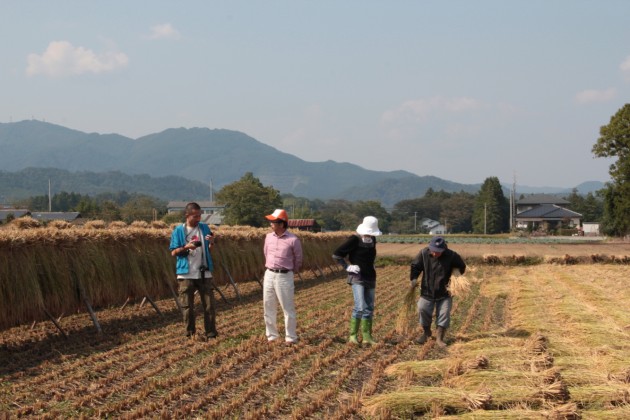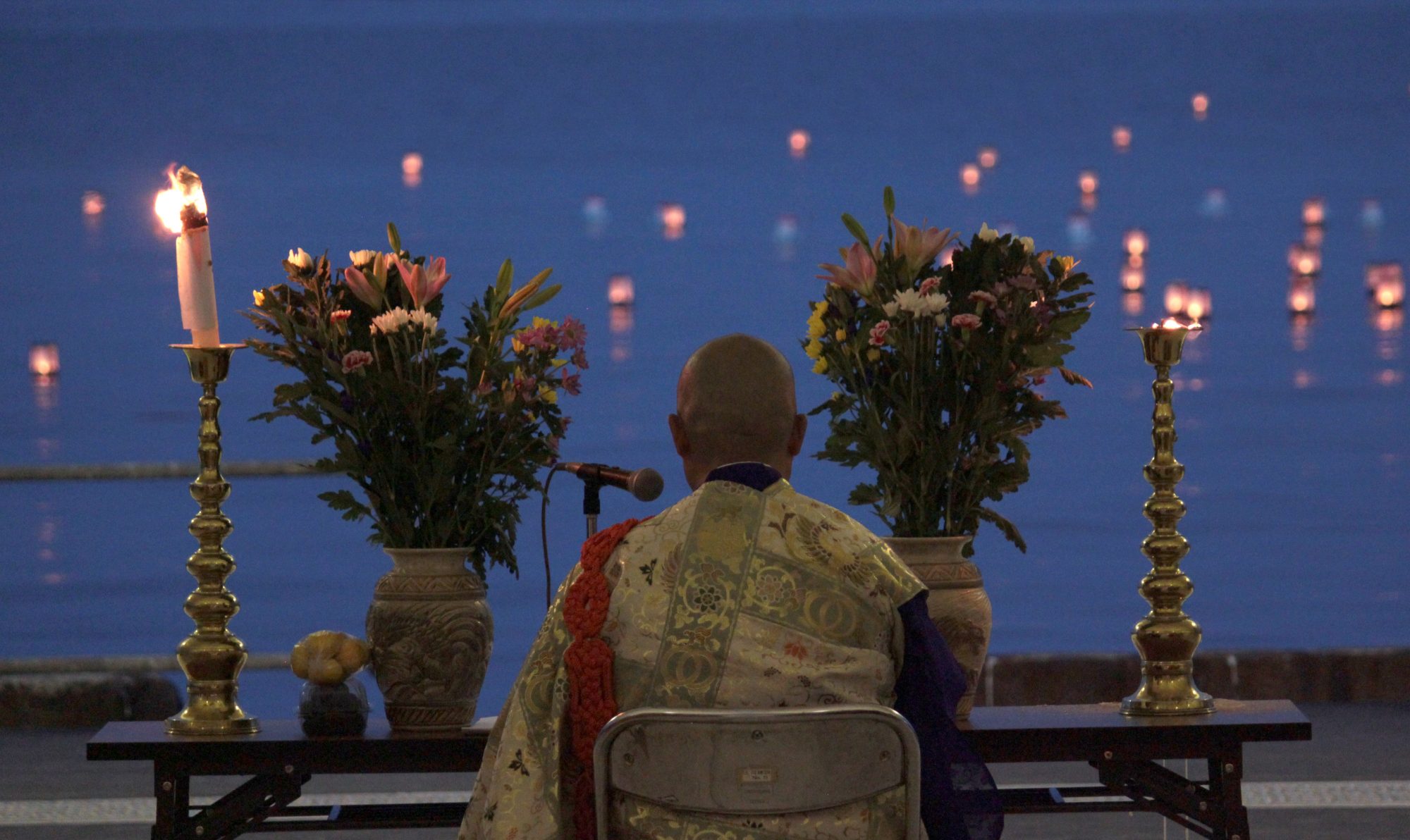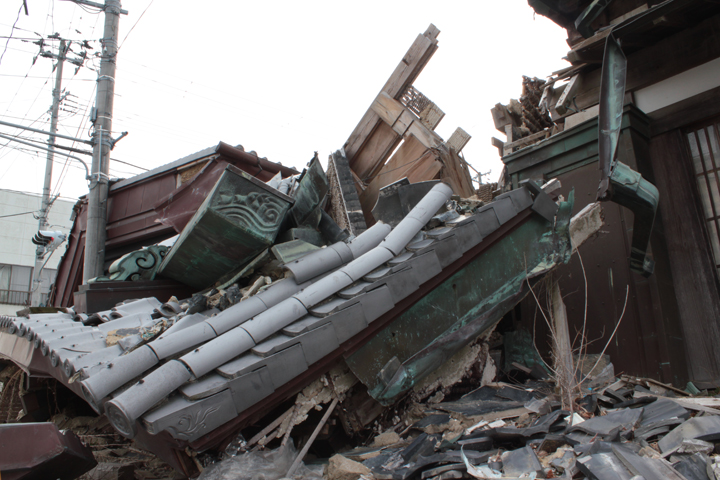Niigata University researchers test the effect of various combinations of soil additives on the absorption of radioactive cesium by Sugeno’s rice.
Saitos spread zeolite
One Year Anniversary Memorial for Higashi Nihon Earthquake
AQ SIFE presents a One Year Anniversary Memorial for Higashi Nihon Earthquake. Featuring a screening at 5pm of preview footage from Uncanny Terrain, an exhibition of photos from the disaster, and testimonials from relief volunteers. Free. Food and beverages will be served. Friday, April 20, 4-6 p.m. at Aquinas College Wege Ballroom, 1607 Robinson Road SE, Grand Rapids, Michigan.
Return to Shikisaisai
-
 Hiroaki Yoshida had his rice tested at several labs. None of it showed any detectible radiation.
Hiroaki Yoshida had his rice tested at several labs. None of it showed any detectible radiation. -
 Despite testing clean, Yoshida struggles to find new customers for rice grown on the southern outskirts of Fukushima.
Despite testing clean, Yoshida struggles to find new customers for rice grown on the southern outskirts of Fukushima. -
 To fight a dropoff in sales, Yuko and Hiroaki Yoshida bring their rice and mochi into Tokyo every weekend for the Aoyama Farmers Market.
To fight a dropoff in sales, Yuko and Hiroaki Yoshida bring their rice and mochi into Tokyo every weekend for the Aoyama Farmers Market. -
 Grandma Yoshida says anything you eat could be radioactive, but you still have to eat.
Grandma Yoshida says anything you eat could be radioactive, but you still have to eat. -

-

Our second year with Fukushima farmers fighting for their land

The organic farmers of Fukushima have spent the past year coping not only with the contamination of their ancestral land with radioactive fallout from the Fukushima Daiichi Nuclear Power Plant, but also bureaucratic barriers to compensation, inconsistent guidelines from a government scurrying to project an illusion of normality, scarcity of accurate information and equipment to understand the contamination, hostility from a frightened public, and a steep drop in sales that threatens to undermine the regional economy and shatter their way of life.

The farmers have steadily educated themselves about the threat of radiation and how to cope with it, adapting traditional methods, acquiring testing equipment and incorporating experimental techniques to prevent their crops from absorbing cesium and try to decontaminate the land with minimum loss of its fertility. But will their efforts be enough to keep organic farming alive in northeast Japan?
After spending five months in 2011 following the farmers through the growing season, filmmakers Junko Kajino and Ed M. Koziarski are back in Japan to capture the second year of the nuclear crisis for our documentary Uncanny Terrain. We thank you for joining us on this journey. And we hope that you will continue to support us by spreading the word about this project, and making a tax-deductible contribution to our IndieGoGo campaign, which runs through May 1.
In March we held a series of preview screenings in New Jersey and Massachusetts, with lively and thoughtful audience discussions after each screening. We can provide preview footage for your school, organization, or venue, and either travel there or join you via teleconference. Please write us to inquire.
Michigan screening, save the date: we will screen preview footage at an exhibition of photography from the aftermath of the earthquake and tsunami, April 20 at Aquinas College in Grand Rapids, Michigan. Details TBA.
Asami Girls
One Year After the Meltdown
To the East Coast and On to Fukushima
Today Uncanny Terrain codirector Junko Kajino begins an East Coast mini-tour, presenting scenes from the in-progress documentary for schools and community groups. Please join her if you’re in the area.
- Fri 3/2 – 7PM – Georgian Court University, Little Theatre, 900 Lakewood Ave, Lakewood Township, NJ
- Sat 3/3 – 6PM – Ocean County Building, Skywalk Cafe, 2nd Floor, 129 Hooper Ave, Toms River, NJ
- Sun 3/4 – 4PM – Hartsbrook School, Piening Hall, Upstairs auditorium, 193 Bay Rd, Hadley, MA Note corrected time
- Mon 3/5 – 6:30PM – First Church in Salem, Unitarian, 316 Essex St, Salem, MA
- Tue 3/6 – 6PM – Cambridge Friends Meeting Center, 5 Longfellow Park, Cambridge, MA
 Filmmakers Junko Kajino and Ed M. Koziarski spent five months inside Japan’s nuclear contamination zone for our documentary Uncanny Terrain – living and working with the farmers, researchers and volunteers who have committed themselves to take the nuclear crisis as an opportunity to build a better society. We’re going beyond disaster reporting, to show what it is really like for these people who refuse to bow to devastating odds.
Filmmakers Junko Kajino and Ed M. Koziarski spent five months inside Japan’s nuclear contamination zone for our documentary Uncanny Terrain – living and working with the farmers, researchers and volunteers who have committed themselves to take the nuclear crisis as an opportunity to build a better society. We’re going beyond disaster reporting, to show what it is really like for these people who refuse to bow to devastating odds.Now we need your help to return to Japan and revisit those working on the front lines of the nuclear crisis, as they mark the one-year anniversary and the farmers prepare to plant again.
 We need to raise $10,000 by March 31 to cover the cost of traveling to Japan and shooting there through the April planting. Please join us by donating to and sharing our new IndieGoGo campaign. We encourage PayPal contributions because they are tax-deductible, and funds are available to us immediately. Thank you to everyone who has already supported Uncanny Terrain. Please send this invitation to your friends. Join the campaign on Facebook.
We need to raise $10,000 by March 31 to cover the cost of traveling to Japan and shooting there through the April planting. Please join us by donating to and sharing our new IndieGoGo campaign. We encourage PayPal contributions because they are tax-deductible, and funds are available to us immediately. Thank you to everyone who has already supported Uncanny Terrain. Please send this invitation to your friends. Join the campaign on Facebook.
 The organic farmers of Fukushima prefecture toiled for 40 years to grow safe, nutritious and delicious crops on their ancestral land while two nuclear power plants in the prefecture helped feed Tokyo’s increasingly voracious energy appetite.
The organic farmers of Fukushima prefecture toiled for 40 years to grow safe, nutritious and delicious crops on their ancestral land while two nuclear power plants in the prefecture helped feed Tokyo’s increasingly voracious energy appetite.
Since the March 2011 tsunami triggered the meltdown that spread radioactive contamination on much of the lush farmland of Fukushima and eastern Japan, the farmers have been caught between a government in constant denial of the risks of radiation, and outraged citizens who brand the farmers “child murderers” for continuing to cultivate irradiated land.
 But the farmers, researchers and volunteers are committed to building a comprehensive monitoring and reporting network to inform citizens about contamination levels in food, air, water and land, so families can make their own informed decisions; and advancing experimental methods to decontaminate soil or prevent crops grown on contaminated soil from absorbing radiation.
But the farmers, researchers and volunteers are committed to building a comprehensive monitoring and reporting network to inform citizens about contamination levels in food, air, water and land, so families can make their own informed decisions; and advancing experimental methods to decontaminate soil or prevent crops grown on contaminated soil from absorbing radiation.
Fukushima has demonstrated the need for greater public vigilance to keep all our food and energy producers honest, not just about radiation but about all the potential contaminants that our collective appetites introduce into our bodies and our communities.
Please support Uncanny Terrain and help generate dialogue about these vital issues and assure that the struggles of people in Fukushima can stimulate positive change in the world. Thank you!
Eating Fukushima

by Ed M. Koziarski
North Avenue Magazine
Jan. 28, 2012
When does a victim become a perpetrator? That’s the question that kept coming up as we made our way across the irradiated landscape.
Many foreigners fled Japan after the tsunami triggered a meltdown at the Fukushima Daiichi Nuclear Power Plant last March. My wife Junko Kajino and I went the opposite way, spending five months inside the U.S.-declared 50-mile no-go radius for our in-progress documentary Uncanny Terrain.
A pair of Chicago indie filmmakers captures farmers in the aftermath of Japan’s nuclear disaster
 By Jake Malooley
By Jake Malooley
TimeOut Chicago
Jan. 25, 2012
One steamy day last July, Junko Kajino and Ed M. Koziarski found themselves in Fukushima, Japan, hiding beneath a tarp in the back of a pickup truck full of cow feed. The farmer behind the wheel smuggled the filmmakers into a government-mandated 20-kilometer evacuation zone that became highly contaminated with radioactive cesium after a massive earthquake 43 miles off the city’s coast in March. The quake triggered tsunami waves that smashed into the Fukushima Daiichi Nuclear Power Plant, causing meltdowns of three reactors.






























